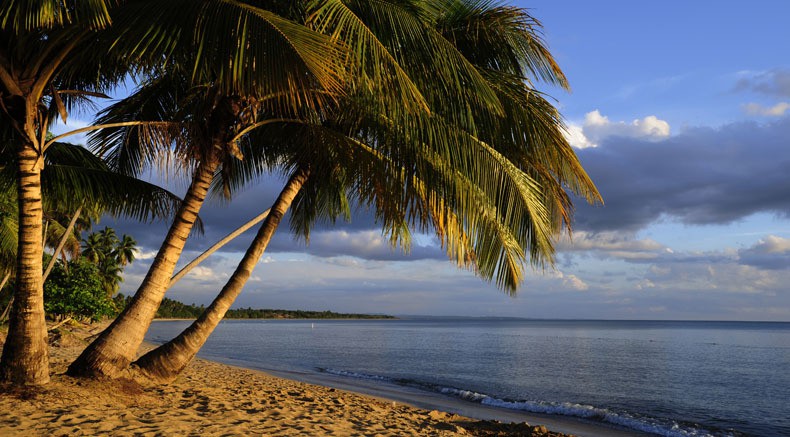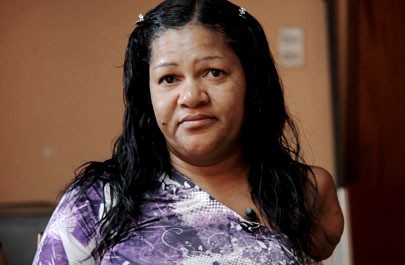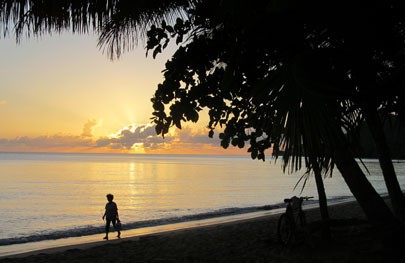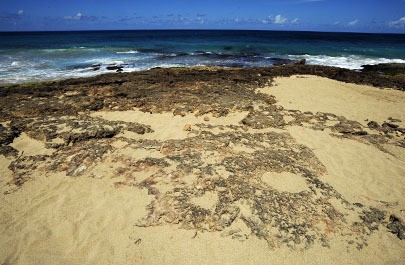Dominican Immigrants Risk Death at Sea, Only to Find Hardship on a New Shore

By Danielle Verbrigghe
Cronkite Borderlands Initiative
SAN JUAN, Puerto Rico -- Gregoria Grullart had heard rumors about women being raped or killed at sea, and of menstruating women being thrown overboard by fellow passengers who feared circling sharks might tip the rickety boat.
"People always hear rumors," Grullart said. "...but they are not rumors. They are true."

Gregoria Grullart traveled the treacherous Mona Passage to Puerto Rico from the Dominican Republic in 2004, risking her life from a unpredictable ocean and even the passengers onboard. Photo by Molly J. Smith |
In January of 2004, Grullart and her younger brother boarded a makeshift boat known as a "yola" under the cover of darkness. The boat, loaded with 145 people, departed from Nagua, a city on the northeastern coast of the Dominican Republic, bound surreptitiously for the western shore of Puerto Rico.
Like the thousands of undocumented Dominicans who have crossed the treacherous waters of the Mona Passage to Puerto Rico, a harrowing 60 to 80 mile journey, Grullart and her brother were at the mercy of the tumultuous sea and their fellow passengers.
In many ways Grullart's story is typical. People from poor countries often make dangerous journeys to neighboring countries with higher standards of living.
But when that journey crosses open ocean, the dangers multiply. And women face particular dangers inherent in traveling in a cramped vessel.
Grullart had nowhere to go when a strong, dark-haired man grabbed. She recalled thinking that the man was strong enough to kill her.
"He wanted to overpower me on the yola," Grullart said. "He wanted to rape me."
Nothing she had heard about the horrors of the journey had prepared her for that.
The captain of the yola shouted at Grullart's attacker and the man let her go.
She had been saved from an attempted rape, but the reality for Grullart of the dangerous journey was finally setting in.
"God, take care of me!" Grullart remembers praying in desperation and fear. "My mother would die if something happens to me!"
She survived. But many who make the journey by yola aren't as lucky.
Dominicans Make Perilous Sea Journey In Spite of Risks
The yolas that cross the Mona Passage are often unseaworthy vessels manned by inexperienced captains and are poorly equipped for dangerous ocean currents. Migrants who board these vessels are vulnerable to the risks of drowning, dehydration and violence. It is easy for a yola to capsize or get lost at sea.
"The majority of the vessels that come in are make-shift, homemade vessels," said U.S. Border Patrol spokesperson Jeffrey Quiñones. "The fact that they travel without life vests and the majority do not know how to swim makes for a dangerous situation."
Last February these dangers were tragically illustrated when a yola carrying about 70 migrants sunk off the coast of the Dominican Republic. Authorities found 52 bodies in the following days. Only 13 passengers survived.
Despite the risks, hundreds of migrants continue to make the journey each year. Illegal immigration into Puerto Rico is on a slight upswing in 2012 after years of sharp decline.
The U.S. Coast Guard and Border Patrol, who work together to intercept undocumented immigrants headed for this U.S. territory, say the peak came in 2004, when they estimate that nearly 12,000 people attempted the trip. The numbers fell to an estimated 589 in 2010.
In the 2011 fiscal year, which ends in September, the estimate rose to 932 migrants attempting the crossing. In the 2012 fiscal year the estimated number of migrants attempting to cross rose by 14 percent, reaching 1,058, as of Sept. 11.
These estimates take into account the number of migrants interdicted at sea by both U.S. and Dominican authorities, abandoned vessels founds on the beaches, migrants apprehended on shore by police, and other known vessels smuggling people from the Dominican Republic.

Yolas often make landfall in the evening when it's difficult to see rocks or coral reefs. Immigrants hide in the brush surrounding beaches or stay with families in coastal communities after landing. Photo by Danielle Verbrigghe |
Migrants who make the voyage are aware of the dangers, according to Frank Graziano, a professor of Hispanic studies at Connecticut College who wrote a book on undocumented Dominican migration.
"There's a normalization or routinization of yola trips and also of death at sea," Graziano said. "People find ways to overcome the fear."
For Grullart, the decision to take the yola was difficult.
In the Dominican Republic, Grullart was a domestic worker who struggled to make ends meet. She had three children to support: two boys and a girl.
"To live there you have to have cash," Grullart explained. "There you live poorly. You have to struggle."
One night Grullart's younger brother called her with an idea. The two of them could find a new life in Puerto Rico. All they would have to do is save 25,000 Dominican pesos, or about $650 USD and take the yola west to a better life.
Grullart was afraid of the passage, but her hope of earning money to send back to children and relatives in the Dominican Republic exceeded her fear.
"I started to think that night he called me, that perhaps it would be the best thing to help my family and help myself and my children who need me," Grullart said.
Eight years later, Grullart laughed as she recalled the decision.
"Sometimes I say, 'it can't be that I'm here'," she said. "That I crossed. That I lasted three days on a yola without thinking about what could have happened to me on the journey."
Danger Begins on Dominican Soil, Continues at Sea
The dangers of a trip can begin even before boarding a yola.
After arranging passage with a smuggler, migrants must often wait in remote areas until a yola captain arrives with a vessel. Weather considerations, as well as the necessity of evading Dominican authorities can also delay departure, according to Milagros Ricourt, a professor of Puerto Rican studies at Lehman College in New York.
"Waiting there is extremely dangerous," said Ricourt. "There can be rape. There can be robbery… It's a very scary time."
The ocean voyage itself is particularly treacherous.
Máximo Taveras, the Dominican Consul in San Juan said the consulate tries to discourage migrants from risking the voyage.
"Many have lost their lives in the Mona Passage," said Taveras.
The conflicting currents through the Mona Passage create a churning effect. In bad weather the waves can be as high as 10 to 12 feet and yolas are often makeshift vessels that can sit less than a foot above the water line.
Grullart was seasick from the moment she set foot on the vessel.
"There were a lot of us who were in that situation, vomiting," Grullart recalled. "There's not a bathroom on there... There's nowhere to do your necessities."
The migrants onboard many boats are packed closely together, in unsanitary conditions, often without water or food. As waves fill the boats with water the passengers frantically bail water with any container they can find.
The shortest distance between the eastern coast of the Dominican Republic and Puerto Rico is about 60 miles, but yola trips are often longer, depending on the point of departure. The journey can take days in these small boats, which must navigate formidable currents.
Disaster can strike when an engine dies or if the vessel gets off course.
"If anything goes wrong," Graziano said, "they run out of gas and then people die slowly of dehydration, unless a boat or a surveillance aircraft sees them and rescues them."
Terror, Desperation and Death
In one infamous case from 2004, a yola full of migrants was lost at sea for almost two weeks. Surviving passengers reported living off the breast milk of two lactating women. A third woman who refused to share her milk was thrown overboard, according to news reports.
In another case from 2008, 33 Dominican migrants who were lost at sea for 15 days told reporters from various news organizations that they resorted to cannibalism to survive.
"There's a thousand ways that the trip can be tragic," Graziano said. "Really it's a matter of luck… Which yola did you get on? How badly does it leak?"
Grullart's vessel was lucky enough to not encounter severe navigational problems, but she recalls the feeling of helplessness aboard the yola, not knowing if she would reach her destination.
"It's difficult being onboard a yola, in the middle of the sea, and everywhere you look there's a wall of water," said Grullart. "...where ever you look it's the same thing."
For Grullart, the horror of the situation was obscured by a seasick daze.
"On the journey all one does is cry and laugh and hold on to father God, and that is it," Grullart explained. "One doesn't do anything else because it's too difficult."
Francisca Figoura, who came to Puerto Rico by yola 25 years ago, remembers the journey only in fragments of sun, hunger and misery.
Her yola, filled with 140 passengers, got stuck on Desecheo, a stony island near the coast of Puerto Rico. Smugglers sometimes abandon migrants there to avoid detection by authorities, according to the Border Patrol. The rocky beaches of Desecheo can be a treacherous environment.
Of the 140 migrants on board the yola with Figoura, nine died before they were rescued.
"They died of the heart, I don't know, of depression, hunger," Figoura said.
Twenty-five years later, Figoura still finds those memories too painful to talk about.
"Sometimes I do not want to remember," Figoura said. "They are ugly memories."
Authorities have not been able to document how many total migrants lose their lives at sea in the Mona Passage. Many deaths go unreported, according to the Coast Guard and Border Patrol.
Coast Guard and Border Patrol agents are often alerted to the presence of a yola in the Mona Passage when worried family members of missing migrants call the stations from the Dominican Republic.
"When you have several phone calls coming in, you know something's wrong," Coast Guard spokesman Ricardo Castrodad said. "It's a big body of water. Where do you start searching?" When migrants spot a helicopter or plane they sometimes cover themselves with a blue tarp, which from a distance can make it hard for Coast Guard pilots to spot them.
The Coast Guard views all reported yolas as potential mass search and rescue operations.
"It just takes one boat for a hundred people to lose their lives," said Castrodad.
Risks Abound as Boats Near Shore
Another serious danger arises as the yola approaches the shores of Puerto Rico. Many yola captains don't know how to safely navigate the Puerto Rican Coast, according to Graziano.
"They will make the trip safely, but then run aground on a coral reef," Graziano explained. "They will crash into a coral rock and then it will gash the yola and the yola will sink."
Captains often try to time the trip so that the boat arrives under the cover of night. The same pitch-black conditions that can hide migrants from detection by authorities can also obscure the dangers of the coral reefs.
Even if the boat does not run aground, when migrants jump from the yola to swim to shore they may be gravely injured by the coral and sharp rocks along the coast.

Sharp rocks and coral fill many of the Puerto Rican coastlines, making yola landfall difficult day and night. The shoreline environmet also poses dangers for immigrants jumping from the boats. Photo by Brandon Quester |
"It's not all sandy beaches," Castrodad explained. "It's jagged edged reefs…. Sharp as knives. And if you just get slightly washed up on one of those reefs, it is going to tear you apart."
Even if a yola successfully avoids breaking apart on a reef, the often frantic scramble of migrants rushing to exit the boat can jeopardize the safety of passengers.
One of Grullart's clearest memories of the journey was the moment when she and her fellow passengers finally spotted the lights of Puerto Rico beckoning through the darkness.
Grullart could not see over the edge of the yola, so her brother hoisted her in the air so she could see the light.
She felt happiness permeating the fear.
The captain killed the engine and the yola drifted up onto the sand. The other passengers crowded the edges of the boat and began jumping ashore.
Grullart's brother grabbed her by her stomach and threw her out of the yola into the shallow water. A woman fell on top of her, crushing her hip and she couldn't stand. She could feel the undercurrents pulling her back into the sea.
Looking back, Grullart's brother noticed she was not behind him. He returned and pulled her out of the water, saving her from another near disaster.
Grullart said she almost drowned that day.
"But thank God I'm here, going through my thousands of things, but I'm here," she said.Evading Capture, Making a Living
When immigrants hit the beach, they must run for cover. Some hide for days in the brush. Others seek cover in houses along the beach.
People in coastal communities are often willing to harbor immigrants, according to Border Patrol agent Xavier Morales. When immigrants call relatives or friends to come pick them up, the people harboring them will then demand money.
"They negotiate a price to either deliver those aliens, or take them to a neutral place where the relatives can come and pick them up," said Morales. "That's very common in those… coastal communities."
When Grullart reached the beach of Arecibo, on the northwestern coast of the island, she hid for about six hours on an abandoned bus that was parked out of sight from Border Patrol. Grullart knew nobody in Puerto Rico, but one of the women who hiding with her had someone waiting for her and allowed Grullart and her brother to go along.
After three days, Grullart began to work. She found a small studio apartment for herself.
Grullart worked hard, hoping to pull her family in the Dominican Republic out of poverty, but things did not go as expected.
Many immigrants arrive in Puerto Rico with inflated expectations of the life they will find, according Taveras.
"People will sell them the idea that Puerto Rico's economy and situation is in magnificent condition," Taveras explained. "They find the reality here very different… The life they were sold, the life they were promised, they find it totally different."
Because wages in Puerto Rico are much higher than in the Dominican Republic, migrants are often blind to the fact that the cost of living is higher in Puerto Rico too, according to Graziano.
"The wage differential is extraordinary and that's a big attraction for them," said Graziano. "But what they don't factor in is that their expenses are going to go up too."
Many migrants find that they cannot find regular jobs in Puerto Rico. Those who do find employment end up taking the lowest tier positions that other Puerto Ricans do not want.
"They think they are going to have access to easy wealth, that they are going to be rich and that their families are going to make it out of poverty," Graziano said. "Their purpose is to support their families, but they realize they can't even earn enough to support themselves here, let alone send money home."
Immigrants who arrive without documentation are also vulnerable in other ways.
"The migrants have an idea that once they make it to Puerto Rico, they are going to achieve the American dream," said Castrodad. "The truth is they go into a life of hiding."
Grullart worked hard at various temporary jobs in order to send money to her children. Her brother went down a different path, smoking and selling marijuana.
Six months after she reached Puerto Rico, Grullart received a call from back home. Her father was bedridden. He died shortly after. She was an ocean away.
American Dream Turns to Hardship
Life was hard. Grullart entered into another abusive relationship. She was raped. Her domestic partner threatened to kill her. She tried to stay positive and kept working.
Grullart had been in Puerto Rico for eleven months when she lost her arm. After what she described as a sickness in the arm, it had to be amputated.
After she left medical care, now missing an arm, she had to contend with a man who abused her.
"His threats were constant," Grullart explained. "That he wanted to kill me, that he wanted to stab me, those were his words daily."
Grullart sought help at the Dominican Women's Center in San Juan. With the help of the center, Grullart's abuser was put in jail.
Romelinda Grullón, the center's director, explained that immigrant women are often vulnerable to domestic abuse and sexual assault because of their unprotected position in society.
"There is plenty of abuse when they cross to this country," said Grullón. "Women have been raped before arriving to the country, during the voyage, and after the crossing. Their situation makes them much more vulnerable."
Grullart gained support from the center and learned to work manual labor jobs with only one arm. In spite of everything, she was moving forward with her life. She took whatever work she could get: cleaning houses, working in cafeterias, even doing construction.
"I work construction with ... one hand," Grullart explained, a hint of pride apparent in her steady voice. "You know that construction is men's work. Not every woman with two hands does it."
She was working hard to get by, but then, less than a month after Grullart escaped from her abusive partner, tragedy struck.
Although she had not let domestic abuse, rape or the loss of her arm pull her from the path of hard work she had undertaken to help her family, she could not stop her brother from choosing a different way.
He had been spending time with a friend who had reportedly robbed a "bichote," a big shot drug dealer.
On June 16, 2005, Grullart's younger brother was boarding a bus, next to his friend when they were hit with gunfire. Grullart's brother was killed. She lost her only family in Puerto Rico, the brother who had inspired her to leave the Dominican Republic, the brother who had protected her on the yola.
Grullart found the reality of life in Puerto Rico to be very different than the American dream she had envisioned.
At the women's center, Grullón helps many women who find themselves in similar positions.
"It is a community that is not sound. They have no representation in Puerto Rico, in the community, and that will make them very vulnerable," said Grullón.
The women's center has helped women like Grullart by providing legal assistance, advocacy and emotional support. Grullón explained that immigrants who make it successfully across in a yola still have to face many obstacles.
"It has been an uphill struggle here in Puerto Rico," Grullón said, "because there is also a lot of racism and xenophobia against the immigrant community."
Some migrants who risk their lives to take the yola across to Puerto Rico end up voluntarily returning to the Dominican Republic, according to Graziano.
"A lot of people give up and go home," Graziano said. "Especially now it's really hard now. The economy is bad here. It's worse in Puerto Rico and they just can't get jobs."
Finding solace in the Dominican Women's center, Grullart says she gains strength through her will to help her remaining family, and the new family she has gained through the center. "My mother needs me," she said. "My brother's three daughters that are small also need me. My children need me. And I have to be here for the center and these women."
Every morning Grullart, who celebrated her fortieth birthday in March, gets up. She cooks. She cleans. She works, when work is available. She moves forward with strength and optimism.
"I live like that the whole day," she said. "Active. Onward. Fighting."
Back to Top
